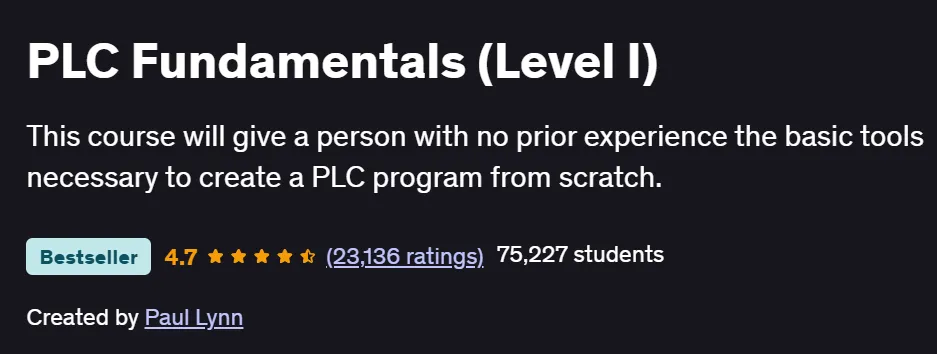What will you in PLC Fundamentals (Level I) Course
- Understand PLC architecture, hardware components, and software environments.
- Develop and simulate ladder logic programs using industry-standard platforms.
- Implement timers, counters, and advanced instructions for process control.
- Design sequenced and conditional control flows for real-world automation tasks.
- Integrate Human-Machine Interfaces (HMIs) and basic SCADA concepts.
- Configure industrial communication protocols (Modbus, Ethernet/IP) for device networking.
Program Overview
Module 1: Introduction to PLCs & Software Setup
⏳ 45 minutes
Overview of PLC hardware: CPUs, I/O modules, power supplies.
Install and configure the PLC programming environment (e.g., RSLogix, TIA Portal).
Understand simulation tools and setup a virtual PLC for practice.
Module 2: Ladder Logic Fundamentals
⏳ 1 hour
Learn basic ladder elements: contacts, coils, and power rails.
Create simple on/off control circuits and test in simulator.
Apply rung organization and commenting for maintainable code.
Module 3: Timers, Counters & Data Handling
⏳ 1 hour
Configure on-delay, off-delay, and retentive timers.
Implement up/down counters and compare operations.
Use data registers, move instructions, and arithmetic operations.
Module 4: Sequencing & Advanced Instructions
⏳ 1 hour
Design multi-step process sequences with state machines.
Utilize advanced instructions: PID, shift registers, and mask/compare.
Integrate subroutines and modular function blocks for reuse.
Module 5: HMI Integration & SCADA Basics
⏳ 1 hour
Create graphical interfaces: buttons, indicators, and trends.
Link HMI tags to PLC addresses and simulate operator interaction.
Understand SCADA architecture and data acquisition fundamentals.
Module 6: Industrial Networking & Protocols
⏳ 45 minutes
Explore Modbus RTU/TCP and Ethernet/IP configuration.
Set up communication between multiple PLCs and HMIs.
Diagnose network issues using built-in protocol monitors.
Module 7: Hands-On Projects & Case Studies
⏳ 1 hour
Build a conveyor belt control system with start/stop sequences.
Implement safety interlocks and emergency stop logic.
Review real-world automation scenarios and best practices.
Module 8: Troubleshooting & Maintenance
⏳ 45 minutes
Use diagnostic tools: watch windows, force I/O, and error logs.
Identify and resolve common programming and wiring faults.
Apply preventive maintenance strategies to ensure uptime.
Get certificate
Job Outlook
- High-Demand Roles: PLC Programmer, Automation Engineer, Controls Technician.
- Salary Potential: ₹4–12 LPA in India; $60K–$85K annually in the U.S.
- Growth Areas: Industrial automation, Industry 4.0, robotics, and IIoT connectivity.
- Career Pathways: Leads to roles in system design, project management, and control systems architecture.
Specification: PLC Fundamentals (Level I)
|





